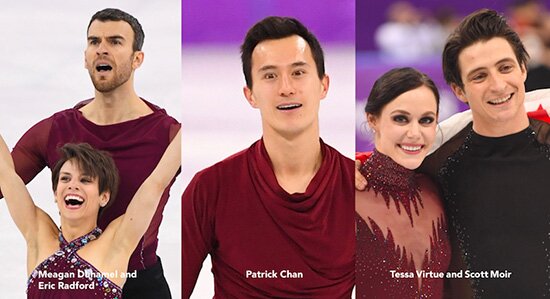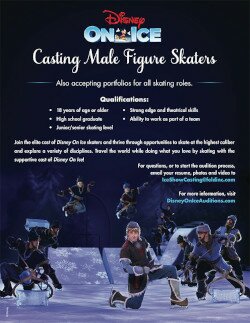
 (This article is ©IFS. No reproduction, translation of or re-posting on third party websites is permitted)
(This article is ©IFS. No reproduction, translation of or re-posting on third party websites is permitted)
In soccer parlance, the term is “golden generation” — that rare confluence of exceptional talent that combines to produce an unprecedented string of success.
Canadian skating fans have had a golden generation of their own to savour the past eight years, one that produced World champions in all four disciplines — and collectively, that group stood on top of the Team Event podium at the 2018 Olympic Winter Games.
It has been an era unlike any other in Canadian skating history, one that reached its peak with a four-medal performance in PyeongChang (the most ever for the country at a Winter Games), and one that came to a close in the days after the flame was extinguished in South Korea.
The heart of that gold-medal team took its final bow in PyeongChang. The pairs team of Meagan Duhamel and Eric Radford ended their career following their free skate at the Games. Patrick Chan officially announced his retirement in April. And though ice dancers Tessa Virtue and Scott Moir have yet to announce their future plans, it is a certainty that they will not be around in 2022 to attempt to add to their vast medal collection.
It will be interesting to see what comes next for Kaetlyn Osmond, who won bronze in PyeongChang, and three weeks later became the first ladies’ World champion from Canada in 45 years. She has yet to announce whether she will stay in the competitive world but, even if she continues for a year or two, the chances of her being around for Beijing 2022 are probably slim at best.
So clearly, the makeup of the Canadian team is undergoing a massive change, the likes of which has not happened in almost a decade. Only one of the senior champions from 2018 nationals — Gabrielle Daleman — will be part of the team next season. With Chan, Virtue and Moir and Duhamel and Radford out of the picture, the podiums at 2019 nationals will have a vastly different look.
Canadian skaters won eight medals at the six-event Grand Prix Series in 2017 — half of them produced by retiring athletes. The exceptions were Osmond, Kaitlyn Weaver and Andrew Poje and Kirsten Moore-Towers and Michael Marinaro. Skaters now absent from the scene claimed two of the three medals Canada won at the 2017 Grand Prix Final.
An indication of what lies ahead in the Canadian men’s field came at this Final where no man qualified — the first time since 2014. Chan, Canada’s only hope of making that top six, landed in fourth at Skate Canada and then withdrew from his second event, NHK Trophy.
Given what transpired in the wake of PyeongChang and the season that preceded it, there is much work that needs to be done to rebuild the national team over the next four years. Skate Canada got a glimpse of what is likely coming next at the post-Olympic Worlds in Milan, Italy.
2018 WORLDS: HIGHS AND LOWS
While Osmond’s victory was the obvious high point and Weaver and Poje skated to a bronze medal, there were also four Canadian entries at the event that did not qualify for the long programs, which put Keegan Messing (men) and Moore-Towers and Marinaro (pairs) in the pressure- filled situation of needing top-10 finishes to preserve two Canadian spots for the 2019 Worlds.
Indeed, the most alarming result for Canada at Worlds came in pairs. Julianne Séguin and Charlie Bilodeau were ninth at the Olympic Games, but landed in a disastrous 22nd place in the short program in Milan, far below the cut to reach the free skate.
Though Messing and Moore-Towers and Marinaro were successful in retaining two spots in each of their respective disciplines for 2019, it was yet another indication that the next generation in Canada will not soon be filling the shoes of those who have now moved on. “Worlds was a mixed bag for us, but we knew that going in,” said Michael Slipchuk, Skate Canada’s high-performance director. “We targeted two disciplines that we felt we had the ability to medal in (ladies and dance) and we did. We walked out of Worlds pretty much with the team size we were expecting (for 2019). Now we move on to the next quad and start to build that depth and get ready for 2022.”
It will take time, Slipchuk admitted, to build in behind whoever the returning group will be, although Daleman, Messing, Moore-Towers and Marinaro, and ice dancers Piper Gilles and Paul Poirier, who were eighth in PyeongChang and sixth at Worlds, are most likely to be at the front of the new wave.
Should Osmond choose to return — and some of her recent media interviews suggest that is a possibility — it would give Canada a World champion to lead the way. “A lot of it is patience. You have to have patience with the skaters coming up behind and not have them step in and feel like they have to replace Patrick, or they have to replace Tessa and Scott, or Meagan and Eric,” said Slipchuk. “Those athletes were there for a long time: Tessa and Scott were at the World level for 11 years, Patrick for 10 years, Meagan and Eric combined probably eight years.
“We have some really good young skaters coming up, especially in the men’s, but we just have to not put unrealistic expectations on them. We have to let them develop. Our plan is to keep developing a well-rounded team leading into 2022 and possibly be even stronger by 2026.”
With this being an Olympic year, Skate Canada gave some of its younger skaters a chance to get their feet wet internationally at Four Continents in late January. The most encouraging result from that competition came from the rising ice dance team of Carolane Soucisse and Shane Firus, who claimed the silver medal — Canada’s lone podium finish.
NEXTGEN
A long-range plan must be a part of any continued growth and that is where Skate Canada’s NextGen program fits in. Headed up by Andre Bourgeois, it is focused on promising skaters that generally fall between 12 and 18 years of age, depending on the discipline. The program is funded by Own The Podium, a not-for- profit organization primarily supported by federal government money that invests in Canadian sports with medal potential at the Olympic level.
“It gives us an opportunity to get our athletes on a progression plan,” said Slipchuk. “Get them involved in sport science at a younger age so as they move through and get to the high-performance level, it’s more ingrained in their training … when it’s a defined program, it’s a lot easier for the athletes and coaches to buy in. It gives us an opportunity to have an expanded pool at a lower level, and to really see what we have rather than trying to hitch our wagon to one or two kids and see where they go. Having a big pool is the key, because you never know where these athletes are going to go.”
The program, which Slipchuk said is still in its “infancy stage,” has already begun to bear some fruit. Joseph Phan, a 16-year- old from Vimont, Québec, produced a silver-medal on the Junior Grand Prix circuit last season and finished the year with a fourth place finish at the World Junior Championships. He also earned the fourth-highest overall men’s score during the Junior Grand Prix season.
Ice dancers Marjorie Lajoie, 17, and Zachary Lagha, 18, who train at the Montréal camp of Marie-France Dubreuil and Patrice Lauzon, earned gold and silver medals at their Junior Grand Prix events, qualified for the Final (where they were sixth) and placed fourth at Junior Worlds.
Perhaps the most intriguing young talent is 13-year-old Stephen Gogolev who will make his Junior Grand Prix debut later this year. Gogolev finished 10th among the senior men at the 2018 Canadian Championships, landing a quad-triple combination and triple Axel in his free skate. His potential seems boundless. “With Stephen, we’re excited to see him get out internationally and see where he fits in,” said Slipchuk.
NextGen has yet to show similar gains in the ladies’ area, where Slipchuk admitted “there’s just a lot in development. We’re going to need a year or two to see how some of them are tracking.”
There is a clear need for new depth in that discipline. Based on the results at 2018 nationals, a large drop-off exists below Osmond and Daleman. The bronze medalist at nationals, Larkyn Austman, made her Olympic debut in PyeongChang but did not advance past the short program either there or at the ensuing Worlds in Milan. Former Canadian champion Alaine Chartrand was the top ladies’ finisher (eighth) at Four Continents, but her results have been in decline for two years now.
On the Junior Grand Prix circuit, Canadian ladies produced only four top-10 finishes in seven events — two each by Aurora Cotop and Alison Schumacher, with Cotop’s seventh at the season-opener in Brisbane being the high-water mark.
2020 AND BEYOND
A key benchmark for Skate Canada’s program development will be the 2020 World Championships in Montréal. When Canada hosted the event in 2013 it produced three medalists, but it will be a stretch to see similar results in Montréal. Slipchuk said Skate Canada is hopeful that some, such as Osmond, may see the event as a lure to stay in the competitive ranks. For the most part, though, it will be a Canadian team still finding its legs halfway down the road to the next Olympic Winter Games in Beijing.
Skate Canada is looking at 2020 Worlds as the mid-point to really get a sense of who they see as potential Olympic team members in 2022, and who might be tracking toward the podium in Beijing. “I think we’ll still be in transition, but we’ll have some legit athletes in there vying for medals,” said Slipchuk. “For some, it might be their first World Championships. We see ourselves being a competitive team, but we will be feeling out where we are with everyone.”
Canada should find itself in the strongest position in the ice dance discipline in 2020. Gilles and Poirier could be on the verge of challenging for a medal, and there is obvious promise in the form of Soucisse and Firus, who placed 14th in their Worlds debut in Milan.
The program is also gaining Laurence Fournier Beaudry and Nikolaj Sørensen, who previously skated for Denmark but will represent Canada starting in the 2018-2019 season. They also train with Dubreuil and Lauzon. “They’re a top 12 team in the world,” Slipchuk said of the duo, “so, our depth in ice dance will be strong.”
That is what needs to be developed in pairs. Only seven teams competed in the senior event at 2018 Canadian nationals — and that number included Duhamel and Radford.
“In pairs, we have only four teams in the cycle right now,” Slipchuk admitted. “Camille (Ruest) and Drew (Wolfe), and Trennt (Michaud) and Evelyn (Walsh) will be seniors. We need to give those teams time to get into the senior mode and work themselves through … I know we’ll see a few new pairs teams come together. We just have to keep working through it.”
Ruest and Wolfe, seventh at Four Continents, made their Worlds debut in Milan but did not advance past the short program. Walsh and Michaud placed sixth at the World Junior Championships, falling one spot lower than what they achieved in 2017. However, Skate Canada sees the possibility for growth with both teams.
The start of every Olympic cycle raises questions, and there are no doubt many for Skate Canada going forward. Given its success throughout the last eight years, there is a much more imposing standard now, which will be difficult to match in the next quadrennial.
“To be at the top of their game for 10-years plus is phenomenal in this day and age and I don’t know if we’re going to see that in the future,” Slipchuk said of the group that exited the competitive scene after PyeongChang. “It’ll be some time before we see a team like that again. That group was a long time in making — since the junior ranks. But we will see it and hopefully, sooner rather than later.”
The nature and history of the sport suggests there may well be someone out there who has yet to make their mark — but could rise to prominence in a hurry. Osmond is one such skater who fit that scenario. She went from being an unknown junior in 2010 to Canadian champion three years later.
Whether there are more like her out there at the lower levels of Canadian skating waiting to bloom, but perhaps not yet showing just how good they can really be … it may indeed take a full quadrennial for Skate Canada to find its way back.
(Originally published in the May/June 2018 issue of IFS)




